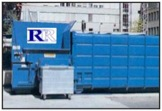
RCR provides a composite solution to collect (where contractually possible) and divert MSW away from landfill and incineration disposal routes. RCR technologies do not require any sometimes segregation of waste components by the waste generator – whether domestic households, commercial concerns or industrial sources and takes these unsorted wastes and extracts the recyclables after treating it all with steam – sanitizing and size reduction – typically an 80 cubic yard load will be reduced to 12 cubic yards and around 20 tons in weight – so typical waste components are size reduced and sanitized. These are treated on site for enhancement of value. Then the enhanced items are sold to end-users.

The organic fraction has been size reduced and largely homogenized into a fibrous material that looks like compost. It is paper, cardboard, labels, food wastes, bones, diapers etc and that is converted into this friable and fibrous material.
This material is the perfect feedstock for the production of soil enhancers, compost or through the use of enzymatic hydrolysis into ethanol within three days of maturation. The residue or sludge from this process dried using parasitic thermal energy and once water content is reduced to manageable levels is burned in a multi-fuel steam raising boiler or combustor as a carbon neutral fuel so that it produces steam that is stored to provide constant high pressure, high temperature steam source to drive the autoclaves and also a constant supply of steam to drive the steam turbine to produce green electricity.

The proven RCR STAG process avoids 98% of all waste from landfill and incinerator and reduces greenhouse gasses by as much as 20%. RCR’s process involves large quantities of steam that size reduces and sanitizes all components that make up today’s MSW – consequently the RCR STAG plants, if located adjacent to existing landfills, are able to process the dialing volumes of MSW being collected and, over time , is able to extract MSW that has been land filled and able to remediate landfills and recover at the same time the lost but valuable recyclables that in some cases will never biodegrade and will remain leachate generators for many decades and produce volumes of Methane (CH4) that is 21 times more aggressive and harmful than Carbon Dioxide (CO2).

Vulnerable landfills, potentially located close to sensitive water sources, or delicate fauna and flora, that historically may never have been constructed in an accepted sanitary manner and without an impermeable membrane or liner, will be a constant environmental hazard and RCR target these vulnerable areas to remediate these vulnerable areas to their original condition and thus restore the delicate balance of nature and avoid consequential damage arising from storm weather intrusion, wave patters or tidal surges that might otherwise further negatively impact on the environment and precious fresh water groundwater sources.

Through the use of static compactors strategically located throughout the designated operational region, Environmental Stewards are employed to collect and manage waste generation, litter, historical fly tipping, illegal or informal dump sites, and transport these accumulations to the static compactor for return to the stag facility and its process. RCR directly employs thousands of Environmental Stewards who will sweep streets, collect litter, assist local residents in waste removal, and to maintain their area in the highest and most cleanliest state.
Problems associated with informal dump-sites are addressed and informal waste pickers or scavengers are offered long-term and guaranteed employment as Environmental Stewards to ensure designated areas are brought up to the highest possible environmental standards. Fauna and flora are protected from issues associated with illegal waste dumping and dump sites are replaced with static compactors that are regularly collected.

These compactors replace informal dumpsites and remove social issues associated with litter, wind blown waste, insects infestations, vermin and odour. All of these issues are mitigated through the siting of these static compactors and effectively replace informal dumpsites and the associated environmental problems arising from the ongoing use of informal and/or illegal dumpsites.
